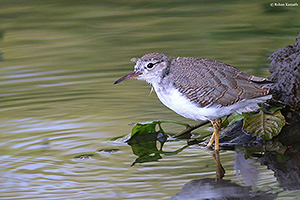Polyandry in the Spotted Sandpiper |
|
|---|---|

photograph of Spotted Sandpiper by Rohan Kamath |
The most widespread sandpiper in North America is the Spotted, and it has one of the most unusual breeding systems found in birds -- polyandry (one female mating with more than one male). Unlike most sandpipers, the Spotted has invaded temperate areas to breed. Apparently it has found Polyandry to be the most successful reproductive strategy for taking advantage of the relatively long breeding season (compared with the season in the arctic and subarctic breeding areas used by most members of this family). The Spotted Sandpiper can be characterized as a "pioneering species" that quickly and frequently colonizes new sites, emigrates in response to reproductive failure, breeds at an early age, lives a relatively short time (breeding females live an average of only 3.7 years), lays many eggs per female per year, and has relatively low nest success. |
|
Initiation of breeding in
the Spotted Sandpiper is influenced by the abundance of
insects, and cessation of breeding normally occurs abruptly
in early July, in anticipation of the decline of insect
populations later in the month (hatchlings from later
clutches would starve). Females arrive first on the breeding
grounds and must compete for males as they appear. Their
vigorous displays occasionally lead to physical combat.
Characteristically, females defend territories encompassing
the individual territories of their male consorts.
Ornithologist Lewis Oring and his colleagues have uncovered
fascinating details of Spotted Sandpiper breeding biology
through their long-term study of an island population in
Minnesota.
The maximum clutch size in these sandpipers is four eggs, each of which weighs about 20 percent of the adult female's body weight. Apparently, it is physiologically impossible for a female to increase the clutch size beyond four, but during the six-to-seven-week breeding season she can lay up to five complete clutches of four eggs each. Each clutch requires about three weeks of incubation, so a female would be hard-pressed to hatch and raise even two broods. Multiple mates enable a female to increase her reproductive output by freeing her from the responsibility for incubation and care of the young. Nonetheless, because of a chronic shortage of available males, females produce an average of only eight eggs per breeding season, although physiologically capable of producing twenty. That explains why females compete so vigorously for mates; indeed, it is fighting among females that limits the number of breeding females on the island. Early in the season there are fewer males than females present. As more males arrive over the following few weeks, the ratio of available males to females becomes more even but only temporarily. When males begin to incubate clutches, they are effectively removed from the pool of prospective mates and, at the same time, the females completing clutches are available again for remating. During the second half of the breeding season, it is not unusual to find six or seven females for every potentially available male. This shortage of males, rather than any scarcity of food resources, limits the reproductive effort of female Spotted Sandpipers. Not surprisingly, experienced females acquire more mates, lay more eggs, produce more chicks, and successfully fledge more young than do inexperienced females. Spotted Sandpipers thus forgo the advantages of having two parents care for eggs and chicks. At least in the study population, however, that does not seem to affect the fledging rate greatly, and the Spotted Sandpipers' reproductive strategy seems to be highly successful. |
|
| SEE:
Polyandry;
Monogamy;
Polygyny;
Promiscuity;
Sandpipers, Social Systems and Territoriality;n
Spacing of Wintering Shorebirds. Copyright ® 1988 by Paul R. Ehrlich, David S. Dobkin, and Darryl Wheye. |
|